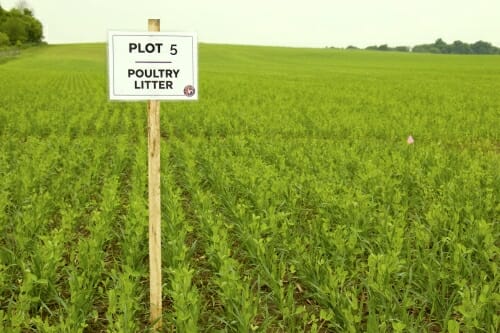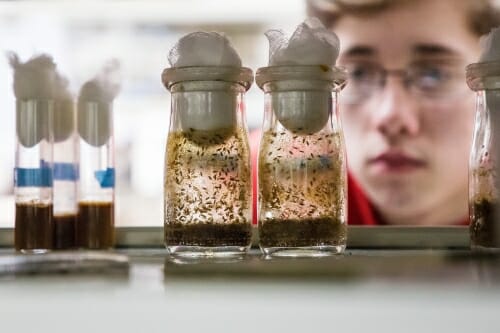UW experts can make you sound smarter at parties
Here are some fascinating facts you can bring up in conversation when mingling at holiday parties. Photo: Rawpixel, via iStock
Unlike humans that can breathe only oxygen (a gas), many microbes can breathe solid compounds.
The observable part of the universe is only about 4 percent. The other 96 percent of it is made of what is called dark matter and dark energy.
A common medication to prevent strokes is named after the Wisconsin Alumni Research Foundation: warfarin.
Those are just a few of the things you may have learned if you read the first edition of Smarter at Parties. Since 2019, Inside UW has served up a hearty dish of interesting tidbits with help from some of UW–Madison’s newest faculty members. As part of their introduction to campus in Inside UW’s New Faculty Focus, we asked them: “What’s something interesting about your area of expertise you can share that will make us sound smarter at parties?”
Have we gotten any smarter over the years? Does a five-ounce potato supply nearly 50 percent of an average adult’s daily requirement for vitamin C?
Yes. And yes.
Whether in-person or virtual gatherings, there’s always more to learn.
Read on for some of our favorite responses. And click for smarter stories from 2019, 2020 and 2021.
“Now that we know the mass of the Higgs particle, it’s possible the universe is unstable and could transition into some other phase that would destroy all life. But if that happens, it will fly through us at the speed of light, and we won’t even know it happened or be able to warn anyone.”
— Kyle Cranmer, who joined the American Family Insurance Data Science Institute in July 2022 as the David R. Anderson Director. He is a professor in the Physics Department with affiliate appointments in Computer Sciences and Statistics.
“Well, I have several paper-cutting techniques that will dazzle your party guests and that I would happily demonstrate if anyone would like to invite me over for a cocktail.”
— Michael Velliquette, assistant professor of foundations, Art Department, School of Education

Americans spend about 90 percent of their time indoors, so built environments have a major effect on them. Photo: Jeff Miller
“Did you know that people in the U.S. spend about 90 percent of their time indoors? If you’ve never thought about how the built environment impacts your behavior, then you’ve probably been in spaces where a designer has done a good job by successfully anticipating likely patterns of behavior and occupant needs.”
— Erin Hamilton, assistant professor, Department of Design Studies, School of Human Ecology
“My lab group is currently really interested in understanding: Why are some communities more susceptible to disease than others? Towards this end, one of our projects aims to sample ponds throughout Wisconsin to assess how pollutants influence amphibian community susceptibility to disease. Given the large number of ponds in the state, it is not possible for us to feasibly assess every single pond so we plan to involve citizen scientists. Our citizen scientists are 5th graders! To train our 5th graders, we use resources put together by an interdisciplinary team of undergraduates. Resources have included: lesson plans, art shows, graphic novels, children’s books, card games, and a mobile app. Learn more about this effort here.”
— Jessica Hua joined the UW–Madison faculty in August 2022 as an assistant professor in the Department of Forest and Wildlife Ecology.

The future of farming is digital. Photo by David Tenenbaum
“The future of agriculture is digital. Decisions will be based on sensors, tractors will be self-driving and farming will be app based.”
— Emily Bick joined the UW–Madison faculty in July 2022 as an assistant professor in the Department of Entomology and a pest ecology extension specialist in the Division of Extension.
“The rumen is a sodium-rich environment that has been considered analogous to an “inland sea.” Many species of bacteria that colonize the rumen require sodium for a variety of physiological functions and cannot grow without sodium. The rumen can also be viewed as the “world’s largest commercial fermentation process” and one of the most intensive cellulosic bioconversion systems in nature!”
— Hilario Mantovani joined the UW–Madison faculty in March 2022 as an assistant professor in the Department of Animal and Dairy Sciences.

The adult brain makes up 2% of the body’s weight but uses 20% of the body’s metabolism.
“The adult brain makes up 2% of the body’s weight but uses 20% of the body’s metabolism, underscoring how much energy is needed to do all the brain’s calculations. On the other hand, the brain can do all its amazing computations using an estimated power of 20 Watts, less than the peak power usage of a typical energy-efficient laptop CPU. Amazingly, it has been estimated that brains of young children are even more active, they can use more than 50% of their entire resting metabolism on the brain alone!”
— Neil Munjal, MD, MS, assistant professor, Department of Pediatrics, Division of Critical Care
“An occupational hazard about this line of research is that you lose your filter about which anecdotes about reproductive health are party-appropriate and which aren’t. If you’re not careful, I’ll put you right off your hors d’oeuvre.”
— Leigh Senderowicz, assistant professor of Gender and Women’s Studies and Obstetrics and Gynecology,
“It’s still hard to imagine going to parties for me!”
— Ruth Goldstein, assistant professor of Gender and Women’s Studies

A student looks at fruit fly samples. Photo: Hyunsoo Léo Kim
“The fruit fly is a very powerful genetic model system to learn about the fundamental ways in which all cells, organs and organisms, including us, work. In our research, we take advantage of this powerful organism to study how a small number of stem cells in the fruit fly ovaries manage to work in perfect coordination with diet, hormones, and other environmental and physiological factors to adjust how many cells (e.g. eggs) they produce depending on the specific conditions. What we learn can inform us about how many other types of stem cells across many organisms are controlled.”
— Daniela Drummond-Barbosa joined the UW–Madison faculty in September 2022 as a professor in the Department of Genetics.
“Did you know that each state has its own State Soil? Antigo silt loam is the official state soil of Wisconsin. Antigo soil even has its own logo and a song.”
— Inna Popova joined the UW–Madison faculty in October 2022 as an assistant professor in the Department of Soil Science.



